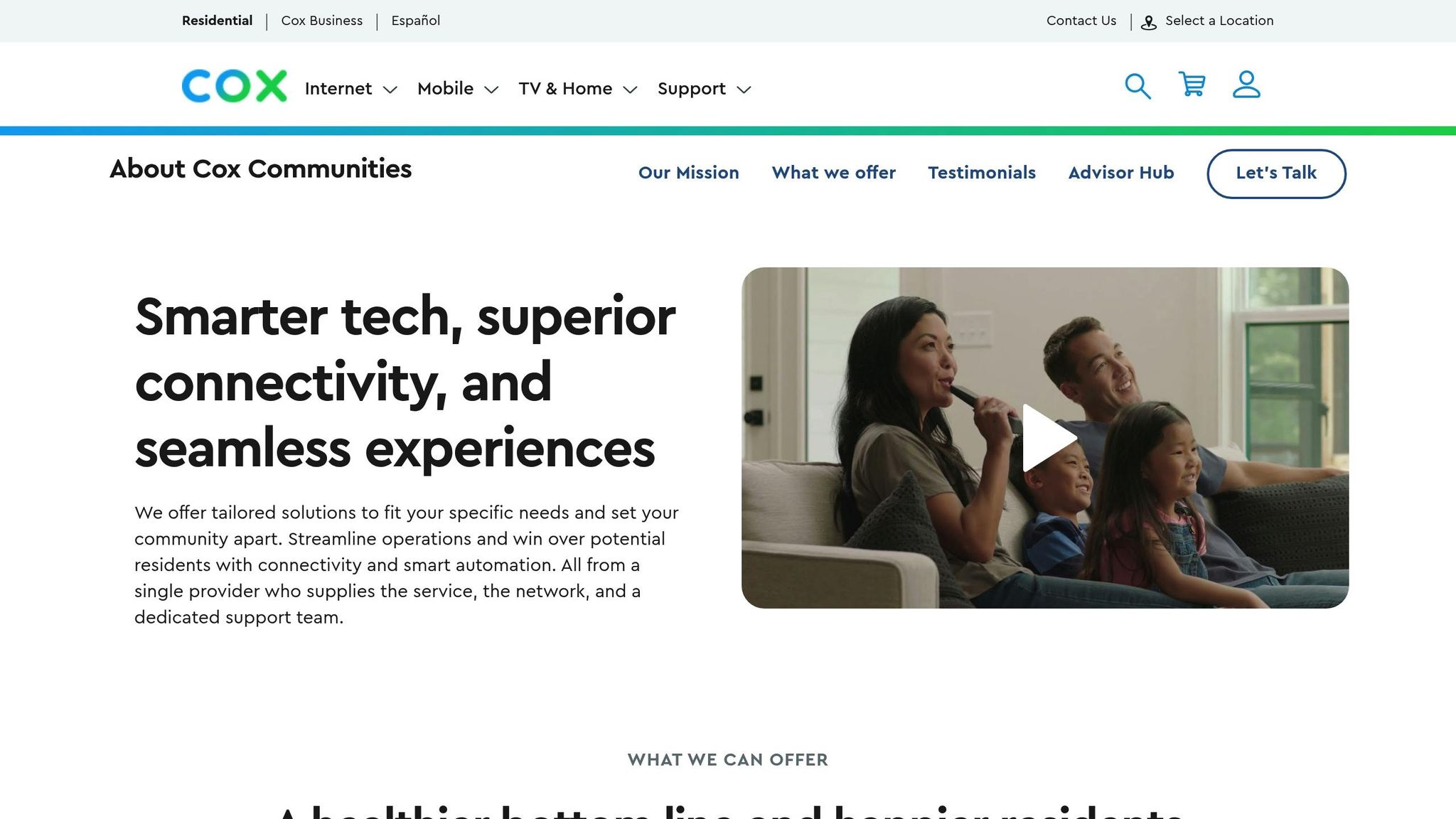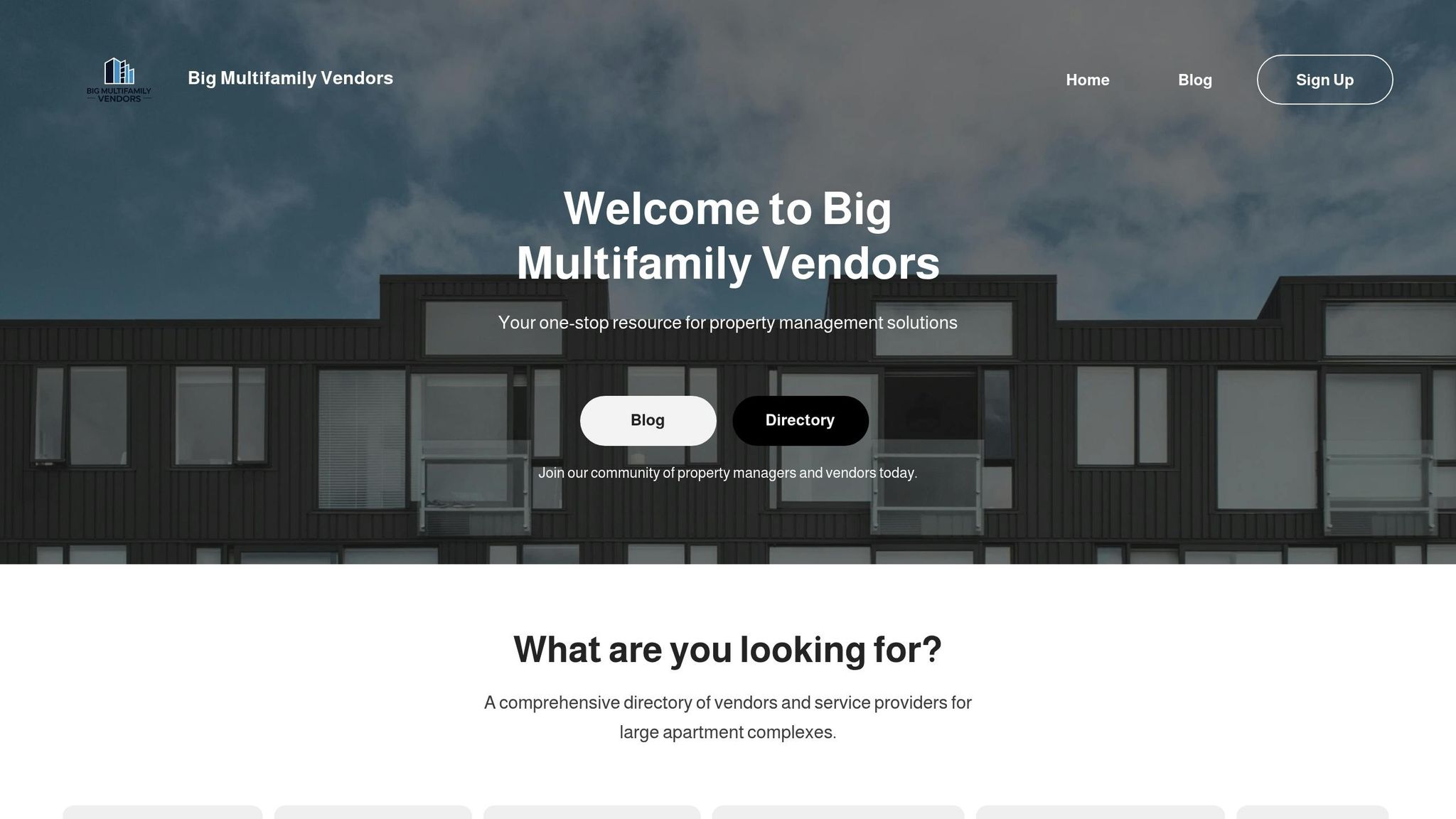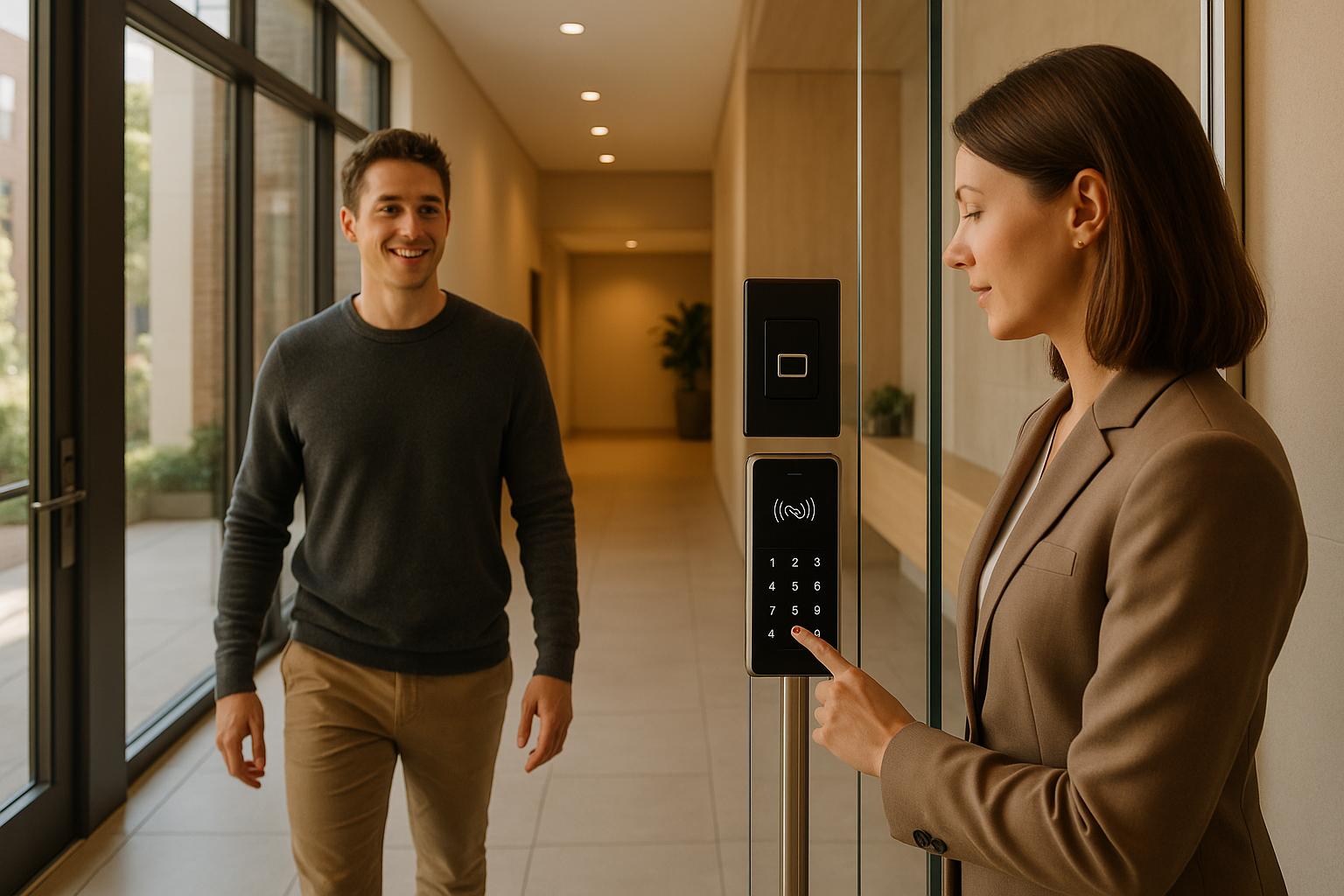Choosing the right IoT device management strategy for multifamily properties boils down to two main options: centralized control or resident-controlled systems. Each has its strengths and challenges, and the best choice depends on your goals for efficiency, tenant satisfaction, and cost management.
- Centralized Control: Property managers oversee all IoT devices across units via a single platform. Benefits include reduced energy costs (up to 30%), better security, and predictive maintenance. However, it requires higher upfront investment ($1,500–$5,000 per door) and ongoing costs ($50–$150 per door annually).
- Resident-Controlled Systems: Tenants manage their own devices, offering more personalization and lower initial costs for operators. Drawbacks include inconsistent energy use, security risks, and increased support needs.
Quick Takeaway: A hybrid approach often works best - centralize critical systems (e.g., security, HVAC) while allowing residents control over non-critical features like lighting. This balances efficiency, personalization, and cost-effectiveness.
Investing in Smart Tech: Practical Guidance for Properties – co-hosted by Cox Communities

Centralized Control: How It Works and What to Expect
Centralized control allows property managers to oversee all IoT devices across their portfolio through a single, cloud-based dashboard. This system provides a unified view of smart thermostats, lighting systems, security cameras, and access controls, eliminating the need for on-site visits [5].
Instead of reacting to issues as they arise, centralized control offers real-time insights and automated decision-making. Data is securely stored in the cloud, enhancing both operational efficiency and scalability [1][5]. Let’s break down the benefits and drawbacks of this approach.
Benefits of Centralized Control
- Energy Management and Cost Savings: Centralized systems optimize energy use, leading to substantial savings. For example, some properties have reduced energy costs by over $20,000 annually through smart building integrations [8]. With energy often making up 25–30% of operating expenses, even small efficiency gains can make a big difference [9].
- Operational Efficiency: Cloud-based IoT solutions automate routine tasks, freeing up property managers to focus on strategic goals and improving resident experiences [1][6].
- Scalability and Flexibility: These systems can easily adapt to new devices or additional properties without hitting system limitations, making them ideal for growing portfolios [5].
- Enhanced Security and Monitoring: In July 2025, ECAM Technologies Corp. reported that their AI-powered live video monitoring systems helped multifamily properties detect potential security threats early. Security teams used tools like audio deterrents or law enforcement dispatch to quickly address issues, minimizing risks and liabilities [ECAM Technologies Corp., 2025].
- Predictive Maintenance: Centralized data allows for maintenance scheduling based on real usage and performance metrics, helping to lower repair costs and reduce resident complaints.
Drawbacks of Centralized Control
- Higher Initial Investment: Depending on the setup, costs for multifamily access control systems range from $1,500 to $5,000 per door. Basic keyless entry starts at about $800 per door, while advanced biometric systems can exceed $7,000 per door. Installation typically adds another 20–30% to these costs [7].
- Ongoing Expenses: Recurring costs include software licensing fees ($50–$150 per door annually), maintenance contracts (10–15% of the system cost), and support services [7].
- User Resistance and Training Challenges: Introducing new systems may face pushback from staff and residents, requiring dedicated training efforts [2].
- Cybersecurity Risks: A single cloud platform connecting all properties increases the impact of potential data breaches. Strong encryption and strict access controls are crucial to safeguarding tenant information [4].
- System Vulnerability: A centralized system depends on consistent power and internet connectivity. Outages can disrupt operations across multiple properties, affecting security and resident comfort [2].
- Complex Integration: Incorporating modern systems into older buildings or diverse infrastructures can cause disruptions if not handled carefully [3].
While centralized control offers many operational advantages, alternative models like resident-controlled systems address some of these challenges by distributing responsibility and reducing reliance on a single system.
Comparison Table: Centralized vs. Resident-Controlled Systems
Here’s a quick comparison of centralized control and resident-managed systems:
| Factor | Centralized Control | Resident-Controlled Systems |
|---|---|---|
| Initial Cost | ~$1,500–$5,000+ per door [7] | Typically lower and resident-funded |
| Ongoing Costs | ~$50–$150 per door annually [7] | Minimal (borne by residents) |
| Energy Management | Optimized across the portfolio [8][9] | Varies by resident behavior |
| Privacy Control | Managed by property operator | Fully controlled by residents |
| Maintenance | Centralized with predictive tools | Resident-initiated requests |
| Security | Professionally monitored | Responsibility of individual residents |
| Scalability | High across properties | Limited to individual units |
| Staff Training | Moderate requirement | Minimal requirement |
| System Reliability | Potential single point of failure | More distributed risk |
Resident-Controlled IoT Devices: How It Works and What to Expect
Unlike centralized systems, resident-controlled models give tenants direct control over their living spaces, offering customization options while introducing some unique challenges.
These systems allow tenants to manage smart devices - whether purchased or leased - through the property’s Wi‑Fi. Control is typically handled via mobile apps, voice assistants, or device interfaces. This setup gives tenants the freedom to adjust settings like lighting, temperature, and security to suit their preferences. A recent study found that 75% of tenants value the ability to personalize smart amenities, highlighting the strong demand for this level of control [13].
Benefits of Resident-Controlled Systems
More Personalization and Convenience
With resident-controlled systems, tenants can create tailored routines. For example, they might set up a mode that adjusts lighting, temperature, and door locks at the same time [1]. This level of convenience appeals to busy renters, with 63% saying they look for ways to simplify their daily lives [10].
Improved Resident Satisfaction
Customization plays a big role in tenant satisfaction. Studies show that 89% of business buyers and 72% of consumers expect services to cater to their specific needs [10]. Additionally, 92% of renters want features that promote better sleep, and 91% prioritize amenities like soundproofing for comfort [10].
Lower Initial Costs for Property Managers
Since tenants handle the purchase and maintenance of their own devices, property managers can focus on setting up smart-ready infrastructure without heavy upfront investment. However, this approach does come with its own set of challenges.
Drawbacks of Resident-Controlled Systems
Security Risks
Tenants' varying levels of diligence in securing their devices - such as using weak passwords or delaying software updates - can leave the system vulnerable to security threats [11].
Inconsistent Energy Usage
Centralized systems are designed to optimize energy use across an entire property, but resident-controlled setups depend on individual habits, which can lead to unpredictable energy consumption patterns.
Increased Support Needs
Not all tenants are tech-savvy, which can lead to a higher demand for technical support from property managers when residents struggle to manage their devices [11].
Integration Difficulties
Coordinating property-wide systems with a mix of resident-owned devices can be tricky. Unlike centralized systems, which are designed for seamless operation, ensuring compatibility across various platforms often presents a challenge [11].
Network Stability Issues
A shared Wi‑Fi network can face performance problems when multiple residents connect numerous devices. Maintaining reliable connectivity becomes a critical concern [12].
sbb-itb-58157f8
4 Key Factors for Your IoT Device Strategy
When shaping your IoT strategy, it's essential to weigh these four major factors. Each one plays a crucial role in shaping your operations, managing costs, and ensuring resident satisfaction.
Energy Management and Efficiency
Energy costs are a significant expense for multifamily properties. Space heating alone makes up 56% of electricity use in these buildings, with lighting at 26% and hot water heating around 20% [14].
Centralized systems can dramatically cut energy usage. By coordinating systems like HVAC, lighting, and water heating based on factors like occupancy and weather, centralized setups can reduce energy costs by up to 30% in commercial buildings, with overall reductions typically around 15–20% [9][15]. This approach ensures consistent energy optimization across the entire property.
"Our secret to success is keeping top of mind that efficiency isn't about using less, it's about using the right amount." – Thomas Stanchak, Managing Director of Sustainability at Stoneweg US [14]
Resident-controlled systems, while offering individual control, can lead to unpredictable energy patterns. For example, smart thermostats may help residents save 10% or more on energy costs [14], but the results depend heavily on user behavior. Specific upgrades like duct sealing can cut HVAC energy use by over 30%, and heat pumps operate at 300–400% efficiency compared to the 80–95% efficiency of gas systems [14]. Centralized systems simplify implementing and monitoring these upgrades across all units.
Occupancy sensors and smart controls can enhance efficiency in both models, but centralized systems leverage these tools more effectively. For instance, centralized platforms can automatically adjust lighting and HVAC in shared spaces based on overall building occupancy, whereas resident-controlled systems typically focus on individual units.
While energy efficiency offers substantial savings, it’s equally important to balance these benefits with strong privacy and security measures.
Privacy and Security Concerns
The rapid growth of IoT - expected to reach 30 billion connected devices by 2025 [17] - brings both opportunities and challenges, especially when it comes to privacy and security.
Centralized systems often raise privacy concerns for residents. When property managers have access to detailed data on heating preferences, lighting habits, and occupancy schedules, residents may worry about being monitored. While this data is valuable for energy optimization, it must be handled carefully to maintain trust.
On the flip side, centralized systems typically offer stronger security. Property managers can enforce consistent security protocols, schedule regular updates, and use robust encryption across all devices. They can also isolate IoT devices from the main network and implement strict authentication practices.
Resident-controlled systems, while preserving personal privacy, present significant security risks. Weak passwords, delayed updates, and inconsistent security measures can leave devices vulnerable to hacking or data breaches [16]. Ensuring consistent security standards becomes nearly impossible when residents manage their own devices.
Regardless of the approach, property managers should adopt privacy-by-design principles and communicate clearly about data collection and usage [16]. Centralized systems benefit from transparency about what data is collected and why, while resident-controlled setups require education and support to improve security practices.
These privacy and security issues also tie directly into compliance and cost management, as discussed next.
Regulatory Compliance and Cost Optimization
Navigating regulatory requirements has become one of the biggest challenges in IoT, surpassing even cost and connectivity concerns [20]. Your choice of IoT management approach will significantly affect how effectively you can meet these requirements.
Centralized systems simplify compliance by offering unified oversight and documentation. Property managers can monitor device performance, ensure updates are applied, and generate compliance reports with ease. For example, ITIC found that 98% of organizations experience downtime costs ranging from $100,000 to over $300,000 per hour [19]. Centralized systems help prevent such costly disruptions through coordinated monitoring and maintenance.
The financial benefits of centralized management are evident. For instance, a healthcare diagnostics company saved $78,791 annually by using real-time monitoring, while a manufacturing company saved $59,835 annually by centralizing its IoT strategy [18]. Centralized systems also support predictive maintenance, which can cut costs by 18–25% compared to traditional time-based maintenance models [19].
Resident-controlled systems, however, can complicate compliance efforts. Limited oversight of device management and security practices makes it harder to track usage, leading to overspending on underutilized devices and misaligned service plans [18]. Managing compliance across numerous individually controlled devices becomes a logistical challenge.
In the long run, centralized systems often provide better cost control. While resident-controlled setups may have lower initial costs, hidden expenses - like increased support requests, security breaches, and compliance issues - can outweigh these savings. IoT is projected to save businesses $1.2 trillion in productivity costs, but achieving these savings requires a coordinated approach [19].
For operators focused on compliance and cost efficiency, centralized systems offer better visibility, stronger security, and simpler regulatory reporting. Though the upfront investment may be higher, the long-term benefits in operational simplicity and efficiency make it a worthwhile choice.
Recommendations for Multifamily Operators
A mix of centralized systems and resident-focused controls offers the best results for multifamily properties. This approach builds on earlier discussions about energy efficiency and security, helping you design an IoT solution that works for both operational needs and resident preferences.
Hybrid Approaches for Custom Solutions
A hybrid model blends centralized infrastructure with resident-managed devices, striking a balance between operational efficiency and personalization.
Start by identifying which devices need centralized management - like security systems, HVAC units, and energy controls - and which can be left to residents, such as lighting and comfort settings. This approach directly addresses the energy, security, and compliance challenges mentioned earlier.
"The implementation of individual hubs restricts security access to individual units, as access to each apartment's smart devices is through its own hub." – Donald Davidoff and Dom Beveridge, D2 Demand Solutions [21]
For connectivity, managed HSIA solutions provide strong Wi-Fi and centralized monitoring. Pairing this with Wi-Fi-enabled edge devices - like thermostats, sensors, and smart lighting - minimizes reliance on proprietary equipment and allows for easier system adjustments when needed [21].
Begin with essential systems like security and HVAC using edge computing. This ensures critical building operations remain functional even during network disruptions [9]. Once these are in place, you can expand to convenience features. For example, integrate occupancy sensors with your showing calendar to create "smart zones" that heat only occupied areas during tours, cutting energy waste while keeping spaces comfortable [9].
Focus on solutions that prioritize both safety and convenience. Analyze local offerings to identify smart technologies with the most impact. Collaborate with providers who can tailor solutions to your property's needs, ensuring a measurable return on investment [22]. Start small - implement one or two centralized systems - and expand as you see benefits.
Using Big Multifamily Vendors Resources

The Big Multifamily Vendors blog is a valuable resource for staying updated on IoT trends. With the global IoT market expected to exceed $4 trillion by 2032, and real estate positioned as a key growth sector [1], keeping up with emerging technologies is crucial for staying competitive.
The vendor directory is another useful tool. It allows you to research and compare IoT solution providers specializing in multifamily applications. Look for partners with a strong track record in energy efficiency - some IoT-based building automation solutions have achieved energy savings of up to 31% [23].
Engaging with resources like these helps refine your hybrid strategy. The Big Multifamily Vendors community connects you with other operators who share their experiences with IoT implementation. This network offers firsthand insights into what works and what doesn’t, giving you a clearer picture before making significant technology investments.
"Multifamily owners, operators and property managers are recognizing benefits such as increased operating efficiencies, reduced operating costs, and reduced utility costs." – Adam Winstanley, Manager of Sales Engineering, Quantum Fiber [22]
Sustainability is also a top priority for many renters - 84% of millennials and 74% of baby boomers consider it a key factor when choosing where to live [24]. These resources can help you find IoT solutions that meet both operational goals and resident expectations. Community discussions often reveal practical tips for engaging tenants and communicating the advantages of smart building features.
AI and machine learning are transforming multifamily operations by improving energy efficiency and security [1]. Meanwhile, advancements like 5G networks and edge computing are enabling faster, more reliable communication between smart devices [1]. By leveraging the tools and insights offered by Big Multifamily Vendors, you can stay ahead of these trends and make well-informed decisions, positioning your properties for long-term success.
Conclusion: Choosing the Right IoT Management Approach
Selecting the best IoT strategy involves finding the right balance between operational efficiency and giving residents control over non-critical features. A hybrid approach often works well - managing essential systems centrally while allowing residents to handle conveniences. This balance not only boosts efficiency but also enhances tenant satisfaction.
The numbers back up this strategy. IoT Analytics projects that by 2025, there will be 27 billion IoT devices in use [25], and the global IoT market is expected to surpass $4 trillion by 2032 [1]. To get started, consider launching small pilot programs and scaling up based on the results.
For guidance on investments, tap into industry resources like Big Multifamily Vendors. These can provide vendor directories, insights into emerging trends, and peer recommendations to help you make informed decisions.
Another critical factor is security. As IoT adoption grows, energy consumption by connected devices is expected to reach 2,300 TWh by 2040 [26]. This makes it essential to implement energy-efficient systems alongside robust security measures.
"IoT security is needed to help prevent data breaches because IoT devices transfer data over the internet unencrypted and operate undetected by standard cybersecurity systems." – Fortinet [27]
Data security isn’t optional - it’s a must. Strong security protocols and vigilant data management are key to maintaining resident trust and staying compliant with regulations.
Many successful operators take a phased approach to IoT implementation. They start by setting clear goals aligned with their organizational priorities, then refine their strategies based on performance metrics [28]. Whether your focus is on reducing energy costs, improving tenant satisfaction, or streamlining operations, the best IoT strategy is one that adapts to your property’s evolving needs while delivering measurable results. A thoughtful, step-by-step implementation can help you navigate these challenges effectively.
FAQs
What should operators consider when choosing between centralized and resident-controlled IoT systems for multifamily properties?
When choosing between centralized control and resident-controlled IoT systems, it's essential to consider a few critical factors:
- Energy management and cost efficiency: Centralized systems are designed to optimize energy use, which can help lower utility bills and streamline operations.
- Resident privacy and independence: Resident-controlled systems give tenants more control, fostering a sense of autonomy and safeguarding their privacy.
- Security and regulatory compliance: Centralized setups often come with advanced security features and make it easier to meet regulatory requirements. However, they demand strong measures to ensure personal data stays protected.
- Management simplicity and scalability: Centralized systems are easier to manage and scale, particularly for larger properties. In contrast, resident-controlled systems can pose challenges when it comes to oversight and scalability.
The best option depends on your priorities - whether you aim to boost operational efficiency or focus on creating a better experience for residents.
What steps can property managers take to secure centralized IoT systems while protecting tenant privacy?
To keep centralized IoT systems secure and protect tenant privacy, property managers can focus on a few essential steps:
- Use robust encryption to secure data as it moves between devices and systems.
- Perform routine security audits to uncover and fix potential weaknesses.
- Set up access controls to restrict who can view or manage sensitive information.
On top of that, ensuring compliance with data protection laws and educating tenants about basic cybersecurity practices can go a long way. These efforts not only strengthen security but also help property managers maintain trust and streamline operations.
What are the advantages and challenges of using a hybrid IoT management strategy in multifamily properties?
Adopting a hybrid IoT management strategy in multifamily properties offers several notable benefits, including boosting energy efficiency, strengthening security, and providing operational flexibility. For instance, smart devices can cut down energy expenses by optimizing usage patterns, while enabling property managers to remotely oversee and control systems like lighting and thermostats.
That said, this approach isn't without its challenges. Security and privacy are major concerns, as integrating multiple systems can expose vulnerabilities if not properly handled. On top of that, managing a variety of IoT devices can be complex, requiring detailed planning to ensure compliance with regulations and seamless operation.
A hybrid strategy aims to balance centralized control with giving residents autonomy, but its success hinges on implementing strong security protocols and crafting a thoughtful, comprehensive plan.


